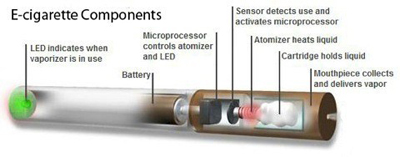News and Events
Frequently-Asked Questions About E-Cigarettes
By Tracy DeCubellis, M.S., Gilchrist County Tobacco Prevention Specialist
September 20, 2013
Recently, many people have come to me with questions about an emerging product on the market called e-cigarettes. There has been a lot of confusion about e-cigarettes, and most people have limited information gathered from advertisements or word of mouth from friends. I have put together the most frequently asked questions about e-cigarettes, along with the answers, to inform communities with currently updated information.
What is an e-cigarette?
An e-cigarette is a battery-powered nicotine delivery device that contains a cartridge filled with what the manufacturers often call “liquid”. This “liquid” often includes candy flavoring, nicotine, and chemicals to create a “vapor”. Most e-cigarette companies offer cartridges of differing nicotine levels, although no testing has been conducted to verify those claims.

Are e-cigarettes considered tobacco?
The FDA has jurisdiction over tobacco products under the Family Smoking Prevention and Tobacco Control Act of 2009, and has stated the intent to regulate e-cigarettes as a tobacco product.
Are e-cigarettes like using the nicotine patch or nicotine gum? Can I stop smoking by using e-cigarettes?
Using e-cigarettes to quit “smoking” isn’t the same thing as quitting nicotine addiction. Nicotine replacement products like the patch or nicotine gum are designed for short-term use with a tapering off period to help break nicotine addiction. On the other hand, e-cigarettes are not marketed for short-term use, or tapering to break nicotine addiction.
In 2010, the FDA sent a warning letter to some e-cigarette manufacturers which marketed their e-cigarettes as smoking cessation drugs. The FDA stated that these companies committed “violations of good manufacturing practices, making unsubstantiated drug claims, and using the devices as delivery mechanisms for active pharmaceutical ingredients1.” The FDA further states that there is no way to know what level of nicotine is in e-cigarette cartridges, or if they are even safe since they have not been thoroughly tested.
What is in e-cigarettes that makes “smoke” or “vapor”?
The FDA has done some limited testing on e-cigarette cartridges and reports that they contain various levels of nicotine (even in products labeled as containing “no nicotine”) and chemicals that are heated by an atomizer and turned into a vapor(2). Although e-cigarette manufacturers claim that the smoke is actually water vapor, this does not appear to be the case.
What are your concerns about e-cigarettes?
1) E-cigarettes are being marketed as a hip, young product with a variety of flavors and flashy colors which clearly appeal to youth.


2) One e-cigarette manufacturer, Blu, is using a cartoon character named “Mr. Cool” to advertise their product. They are also sponsoring smoking sections at theme parks across the country, as well as sponsoring music festivals where minors are likely to be in attendance.
3) Some e-cigarette companies attempt to market their products using a message of “freedom”; however their products contain the addictive drug, nicotine, which is hardly a representation of freedom.
4) The marketing of e-cigarettes mirrors the way Big Tobacco marketed their cigarettes in the past using candy flavoring and cartoon characters.
Are youth in Florida using e-cigarettes?
Yes. According to data collected in a statewide survey of middle and high school students called the Florida Youth Tobacco Survey (FYTS) conducted in 2012, 3.9% of middle school students and 8.4% of high school students have tried e-cigarettes, which represents a 30% increase among middle school students and a 40% increase among high school students since 2011(3).
The most recent FYTS conducted in 2013 reveals that even more youth are using e-cigarettes than the previous year with 4.3% of middle school students and 12.1% of high school students stating that they have ever tried e-cigarettes(4). That represents a 10% increase among middle school students and a 36% increase among high school students between 2012 and 2013.
References:
- (1) http://www.fda.gov/newsevents/publichealthfocus/ucm172906.htm
- (2) http://www.fda.gov/forconsumers/consumerupdates/ucm225210.htm
- (3) Florida Department of Health, 2012 Florida Youth Tobacco Survey: Fact Sheet 12. Youth Electronic Cigarette Use.
- (4) Florida Department of Health, 2013 Florida Youth Tobacco Survey: Fact Sheet 4. Youth Specialty Tobacco Use


